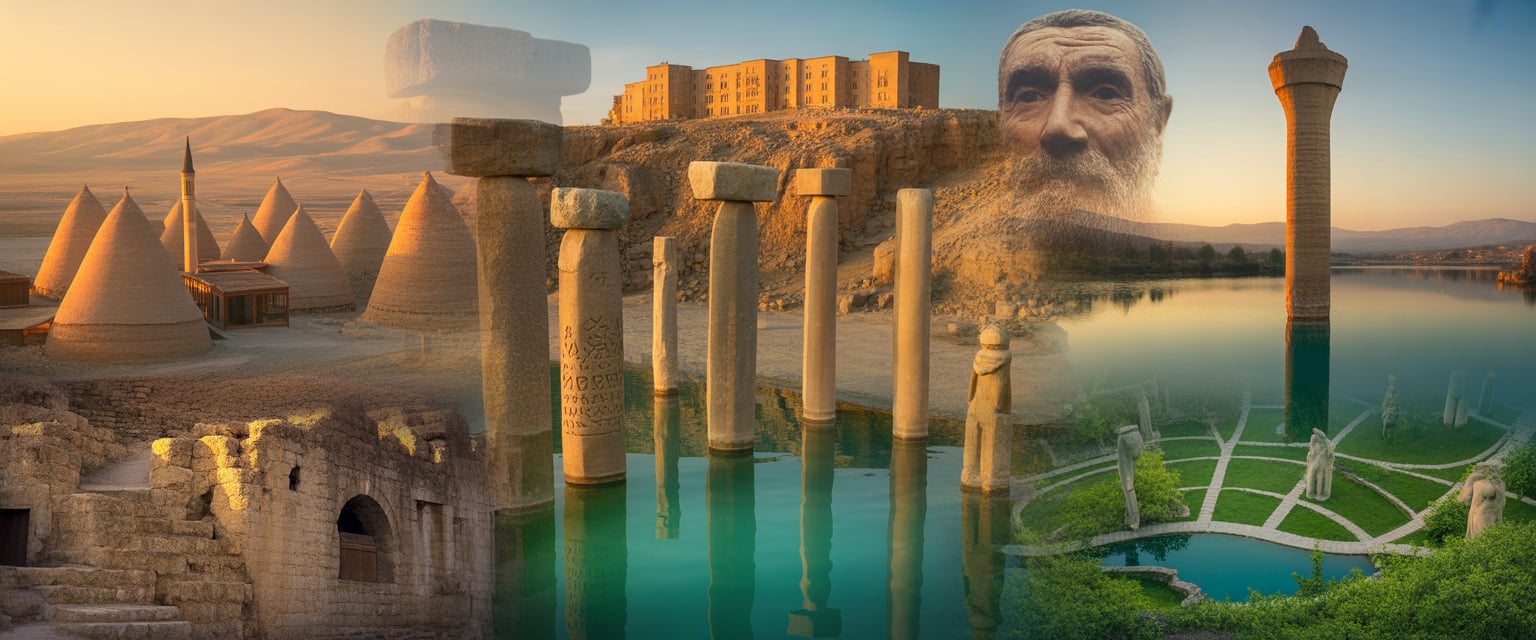Şanlıurfa holds a magical charm that most travelers never truly uncover — a city where every corner whispers forgotten legends and ancient stories. While the region is known for iconic sites, the real wonder lies in discovering its lesser-known pathways, tranquil villages, and untouched cultural corners.
This article, “Hidden Gems: Secret Şanlıurfa Tourist Places to See,” reveals the soul of the city through its quiet sanctuaries and authentic local life. Whether you’re drawn to mystical lakes, rural traditions, or archaeological surprises, these hidden treasures will transform how you experience southeastern Türkiye. Let “Hidden Gems: Secret Şanlıurfa Tourist Places to See” guide you into a world where history lives beyond the crowds.
Hidden Gems: Secret Şanlıurfa Tourist Places to See
Şanlıurfa, often called the “City of Prophets,” holds far more than its famous landmarks. Beyond the crowds at sites like Göbekli Tepe lies a network of quiet villages, ancient ruins, and serene pools hidden from most travel guides. These lesser-known places reveal the authentic heart of Şanlıurfa—where history, tradition, and daily life blend seamlessly.
In exploring these secret places, visitors uncover treasures such as the peaceful Karaköy Village, lush gardens near Ayn Zeliha Pool, and centuries-old mosques that remain central to local life. Each stop offers a chance to experience the region’s genuine culture without the rush of tourist crowds.
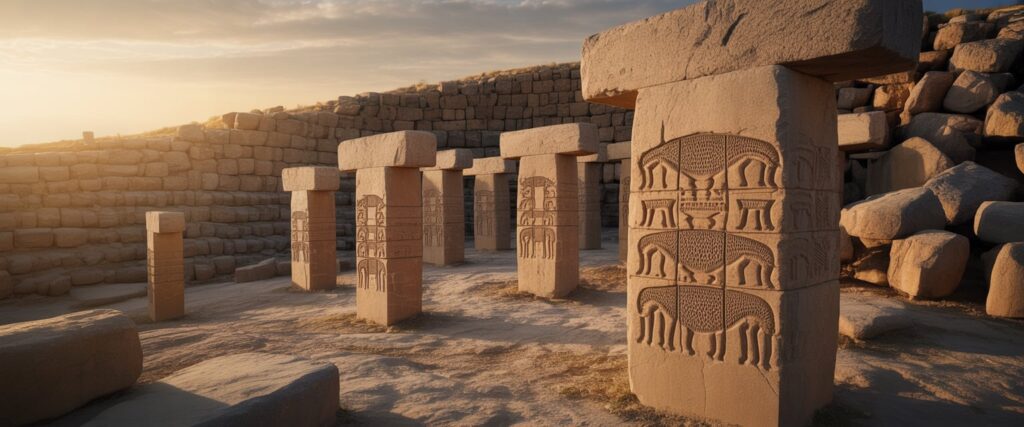
This guide introduces the quiet corners and local experiences that make Şanlıurfa unique. From off-the-beaten-path wonders to hidden cultural gems, each story and sight invites travelers to see a different side of one of Turkey’s oldest cities.
Hidden Highlights of Şanlıurfa: Off-the-Beaten-Path Wonders
Şanlıurfa blends early human history with enduring local traditions. From ancient temples that predate Stonehenge to calm lakes tied to biblical legends, each site reveals part of the city’s deep cultural and religious roots.
Göbekli Tepe: The Ancient UNESCO World Heritage Site
Göbekli Tepe, located about 15 kilometers northeast of Şanlıurfa, is one of the most remarkable archaeological sites in the world. Dating back to around 9600 BCE, it is often called the world’s earliest known temple complex. Archaeologists discovered T-shaped limestone pillars arranged in circular enclosures, each decorated with carvings of animals and abstract symbols.

This site earned UNESCO World Heritage status for its insight into prehistoric social and religious life. Excavations show that hunter-gatherer communities built and used the complex long before agriculture emerged. Visitors can explore viewing platforms that overlook active digs and interpretive displays that explain the site’s role in early human settlement. For practical travel details, see the Şanlıurfa highlights guide.
Balıklıgöl and the Sacred Pool of Abraham
At the heart of Şanlıurfa lies Balıklıgöl, or the Pool of Sacred Fish, a site steeped in local legend. Tradition holds that when King Nimrod tried to execute the Prophet Abraham, God turned the fire into water and the burning logs into fish. The descendants of these sacred carp now fill the pool, which visitors are forbidden to catch or harm.
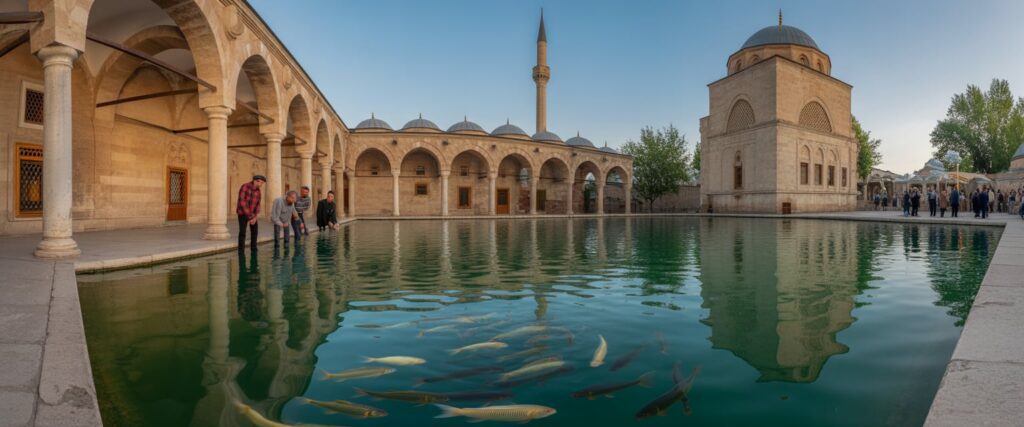
The area features Ottoman-style courtyards, mosques, and shaded walkways. Pilgrims and tourists alike come to watch the shimmering fish and feed them small pellets sold nearby. The peaceful atmosphere around the pool offers a quiet retreat within the busy city. Information about authentic local experiences in this historic district appears on SecretLocale’s Şanlıurfa bazaar guide.
Şanlıurfa Castle: Exploring Urfa’s Panoramic Fortress
Overlooking the city from a high rocky hill, Şanlıurfa Castle (Şanlıurfa Kalesi) offers sweeping views of the old quarter and Balıklıgöl. The site’s origins trace back to the ancient city of Edessa, though much of the visible structure dates to Byzantine and Islamic periods. Two tall Corinthian-style columns stand on the summit and have become a symbol of Urfa’s skyline.
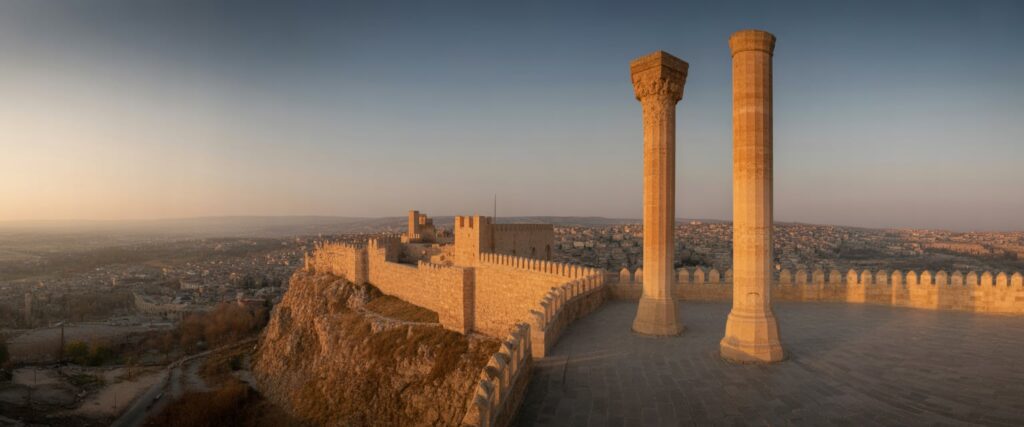
Visitors can hike the gently sloping path to the top and see remnants of old city walls and carved tunnels. The area is particularly striking at sunset, when soft light reveals the layers of history built into the rock. The castle serves as both a scenic lookout and a tangible reminder of Urfa’s long defensive past.
Ayn-ı Zeliha Lake: Mystical Waters Near the Heart of the City
A short walk from Balıklıgöl sits Ayn-ı Zeliha Lake, a smaller but equally symbolic body of water. According to tradition, Zeliha—believed to be the niece of Nimrod—leapt into the fire after Abraham was cast into it, and her flames also turned to water. Local residents regard the lake as a place of purity and quiet devotion.
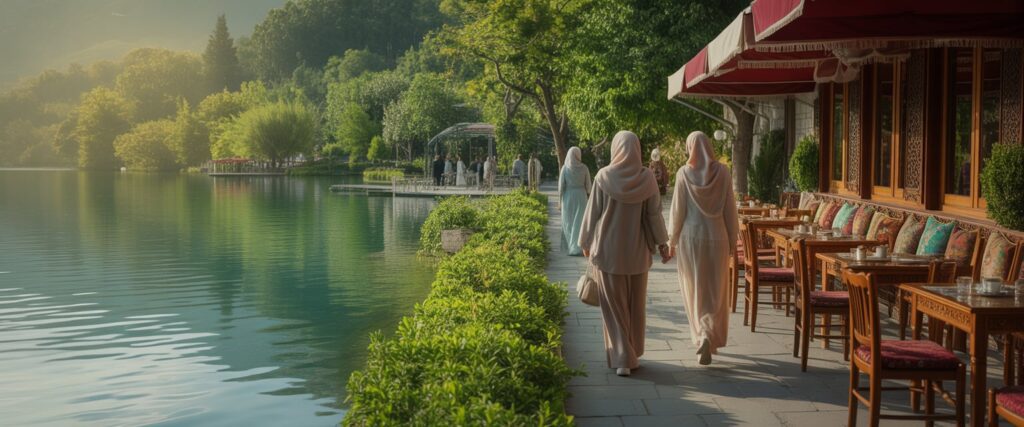
Surrounded by gardens and walkways, the lake attracts visitors who enjoy peaceful strolls or brief rest stops near the water. Cafés around the edges serve Turkish tea, offering a view of the shimmering surface. Together with Balıklıgöl, this site reflects the blend of spiritual history and urban calm that defines Şanlıurfa’s enduring appeal.
Secret Cultural Experiences and Lesser-Known Day Trips
Ancient heritage, rural architecture, and living traditions give Şanlıurfa its deep cultural character. Travelers can explore archaeological wonders, historic homes, and communities that preserve local lifestyles found nowhere else in Türkiye.
Harran and the Beehive Houses
Located about 40 kilometers from Şanlıurfa, Harran is known for its distinctive beehive houses made of mud bricks. Their cone-shaped roofs help keep interiors cool during the intense heat of southeastern Türkiye. Many homes are still in use, offering a rare look into a design developed more than two millennia ago.
Visitors can walk through small courtyards, meet local families, and see the ruins of the ancient Harran University, one of the world’s earliest centers of higher learning. The nearby wells and city walls date back to Assyrian and early Islamic times. A short stop at the archaeological site reveals layers of occupation that trace back to the Bronze Age.
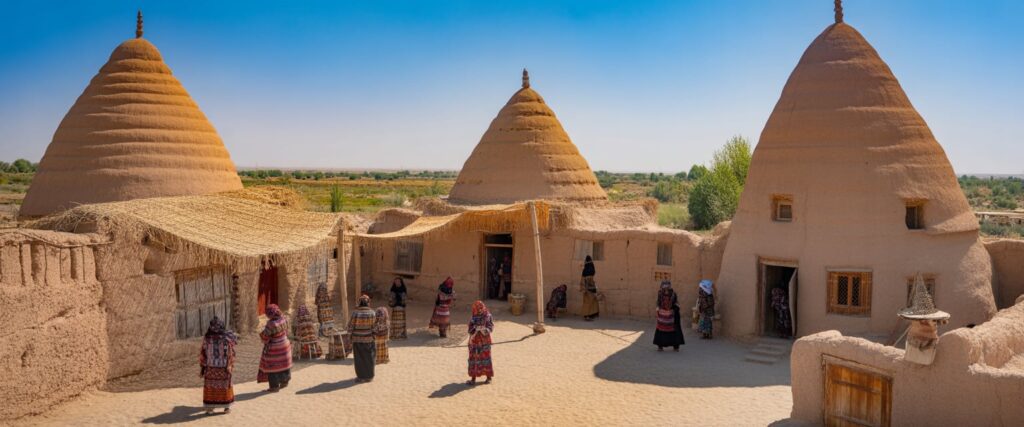
Tip: Local guides often share insights into construction techniques and daily life, making it easier to understand how these homes have endured the region’s harsh climate.
Şanlıurfa Archaeological Museum and Urfa Man
The Şanlıurfa Archaeological Museum holds one of Türkiye’s richest collections of artifacts from the Neolithic and Bronze ages. It displays items unearthed at nearby sites such as Göbekli Tepe and Nevali Çori, highlighting the area’s long history as a City of Prophets and major pilgrimage site.
One of the museum’s most significant exhibits is Urfa Man, believed to be the world’s oldest known life-sized statue of a human. Carved from limestone about 11,000 years ago, the figure’s deep-set eyes and stylized features reveal early artistic skill.
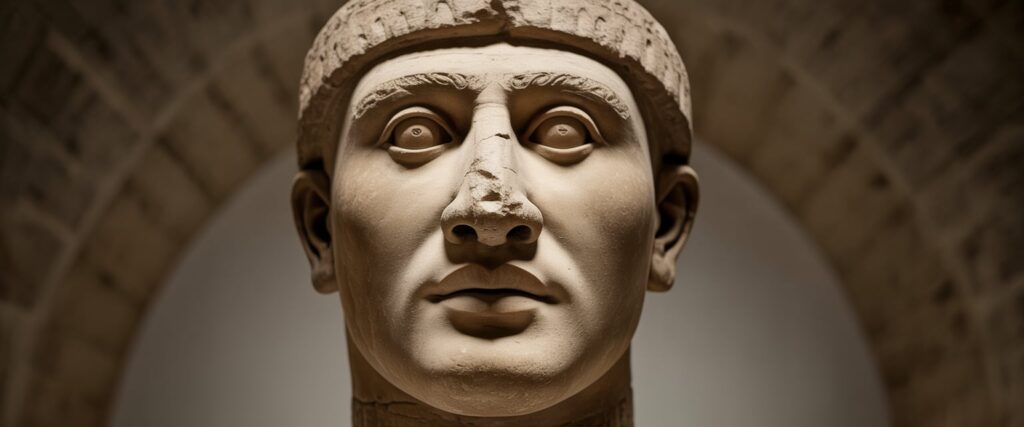
Across the museum courtyard, the Haleplibahçe Mosaic Museum preserves intricate Roman mosaics discovered locally. Depicting scenes from mythology, they provide a detailed look at ancient art in southeastern Türkiye. A short taxi ride from the Şanlıurfa GAP Airport brings visitors directly to this cultural center.
Halfeti: The Sunken Town on the Euphrates
Halfeti, located west of Şanlıurfa near the Birecik district, offers a haunting view of part of the old town submerged under waters from the Euphrates River. What remains above the surface includes stone houses, minarets, and scenic hills.
Boat tours glide past the famous half-submerged Savaşan Mosque, where only the minaret rises above water. The calm setting, paired with the unique reflection of flooded buildings, makes Halfeti an exceptional day trip destination.
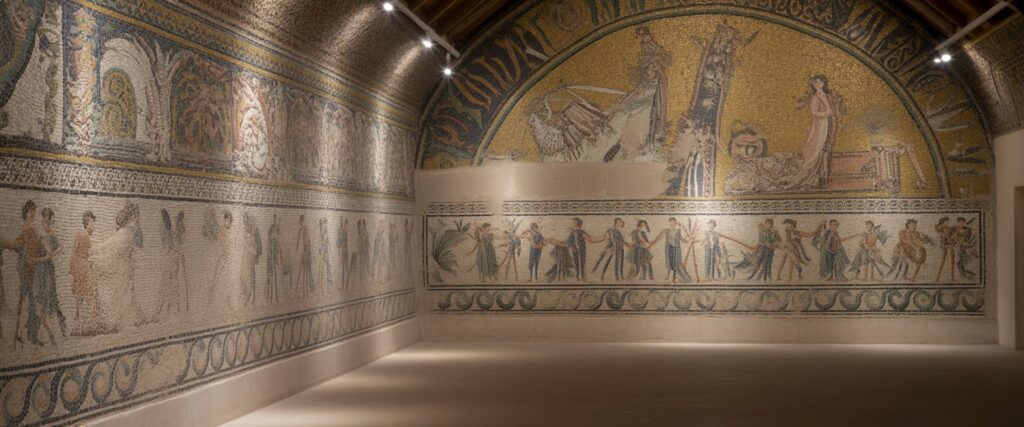
Travelers can enjoy a small café stop to taste menengiç kahvesi, a caffeine-free coffee made from wild pistachios. Trips to nearby Birecik, known for its riverfront and rare bald ibis birds, can add variety to the visit. Those interested in regional culture often continue west to Gaziantep, celebrated for its baklava and culinary heritage.
Exploring Traditional Bazaars and Local Flavors
The Şanlıurfa Bazaar offers an authentic way to experience local life through its maze of stalls and workshops. Merchants sell copperware, textiles, and handcrafted souvenirs made by local artisans. The scent of spices, soap, and fresh bread fills the narrow lanes.
Popular local dishes include çiğ köfte, a seasoned bulgur and pepper mixture shaped by hand, usually served with fresh herbs. Visitors looking for traditional drinks can try menengiç kahvesi or freshly brewed black tea prepared on charcoal stands.
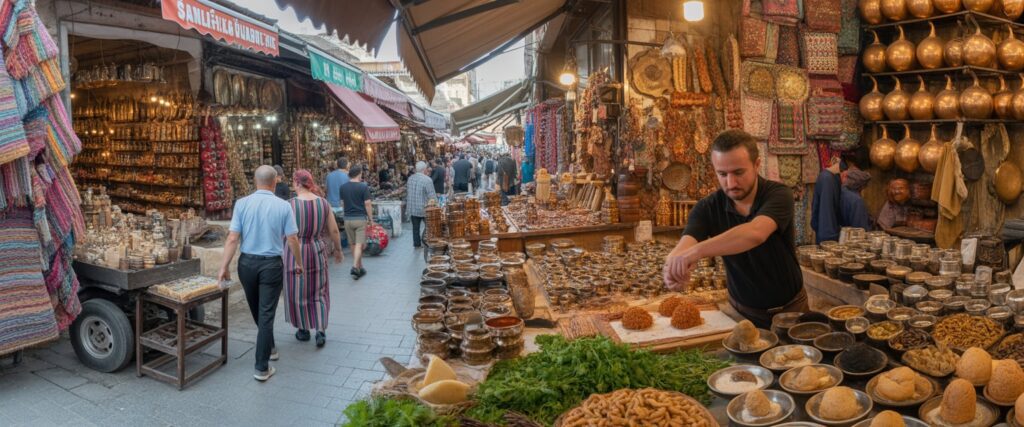
A quick guide to notable tastes can be organized as follows:
| Specialty | Description | Where to Try |
|---|---|---|
| Çiğ Köfte | Spicy raw dough-like mixture | Local eateries near Balıklıgöl |
| Menengiç Kahvesi | Coffee substitute from wild nuts | cafés in old bazaar |
| Baklava | Layered pistachio pastry | regional dessert shops |
Exploring these bazaars encourages direct interaction with local artisans and reveals how Şanlıurfa keeps its traditional economy alive while welcoming travelers interested in genuine cultural exchange.
For travelers inspired by offbeat experiences and hidden cultural corners, guides like Unveiling Hidden Heritage: Exploring Secret and Lesser-Known Cultural Spaces describe how thoughtful travel can help preserve unique sites while deepening cultural understanding.
Conclusion
Exploring Şanlıurfa is more than a journey through history — it is an immersion into living culture, timeless landscapes, and stories preserved far from the usual travel trails. The destinations shared in “Hidden Gems: Secret Şanlıurfa Tourist Places to See” invite you to witness the city with fresh eyes, embracing both its spiritual depth and its everyday beauty. As you wander through peaceful villages, ancient ruins, and serene waters, these experiences remind you why true discovery happens off the beaten path. Let the spirit of “Hidden Gems: Secret Şanlıurfa Tourist Places to See” inspire your next adventure and reveal a side of Şanlıurfa that only a few have truly seen.
Frequently Asked Questions
Şanlıurfa offers travelers a wealth of lesser-known sites, quiet cultural experiences, and authentic local food spots often missed by larger crowds. Visitors can explore ancient ruins, hidden mosques, and community-based experiences that reveal the city’s layered history and living traditions.
What are some lesser-known historical sites to visit in Şanlıurfa?
The ancient Karahantepe archaeological site, located about 35 kilometers east of the city, often receives less attention than Göbekli Tepe but is equally fascinating for history lovers. Here, researchers uncovered stone pillars and carvings that shed light on early human settlements.
The Urfa Castle hill area includes remains of older fortifications and water channels that date to Roman and Islamic times. For visitors seeking details on the city’s preserved monuments, several travel guides highlight places such as Urfa Castle, which offers sweeping city views and insight into Şanlıurfa’s layered past.
Can you recommend off-the-beaten-path cultural experiences in Şanlıurfa?
Travelers can attend small community performances featuring traditional sıra gecesi music—intimate evening gatherings with live instruments and shared meals. These are usually held in local homes or neighborhood venues rather than large tourist restaurants.
Exploring the hidden bazaars of Şanlıurfa allows visitors to interact directly with artisans who produce handmade textiles, copper goods, and spices. The Şanlıurfa hidden bazaars shopping guide offers a path through quieter markets frequented by locals rather than organized tour groups.
Are there any hidden natural wonders to explore in or around Şanlıurfa?
Just outside the city, Karaköy Village provides a peaceful rural landscape surrounded by rolling hills and farmlands, ideal for short hikes and photography. Visitors can escape the busy center while enjoying traditional village hospitality.
Nearby, the Ayn Zeliha Pool, often overshadowed by Balıklıgöl, features clear waters and shaded gardens perfect for a calm afternoon visit. According to 10 Breathtaking Tourist Places to Visit in Şanlıurfa, the site combines natural beauty with local legend.
Where can I find authentic local cuisine in less touristy areas of Şanlıurfa?
Locals recommend small, family-run ocakbaşı restaurants tucked into the backstreets around the old bazaar district. These eateries serve dishes like lamb kebabs, lentil soup, and lahmacun prepared over open flames.
The markets north of Gölbaşı Park also house stalls that sell çiğ köfte made with bulgur and spices—a signature Urfa dish that visitors can sample freshly prepared. Travelers find that avoiding the main tourist squares leads to the most authentic meals.
What overlooked museums or galleries offer unique insights into Şanlıurfa’s heritage?
The Şanlıurfa Archaeology Museum contains extensive Neolithic and Bronze Age finds, including artifacts from Göbekli Tepe. It is highlighted in 10 Breathtaking Tourist Places to Visit in Şanlıurfa for its detailed exhibits about early human societies.
Nearby, the smaller Haleplibahçe Mosaic Museum displays intricate Roman-era mosaics discovered during local construction projects. Its quiet environment gives visitors more time to study each piece without the congestion of larger museums.
How can I participate in local traditions and events in Şanlıurfa without the crowds?
Visiting during regional festivals outside major holidays provides the best chance to witness genuine community traditions. Annual village fairs often include folk dance, handicraft markets, and local storytelling sessions open to guests.
Cultural travelers can also join workshops focused on traditional weaving or calligraphy run by artisans in neighborhood cooperatives. The Şanlıurfa tourism overview lists cultural events and community-led exhibitions that welcome respectful participation.
